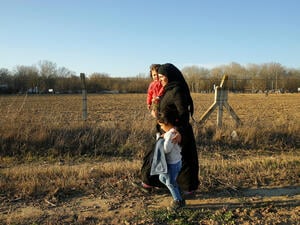Gulf of Aden
Gulf of Aden
More than 22,000 people have crossed the Gulf of Aden from Somalia to Yemen this year in smugglers' boats. At least 355 died making the perilous voyage and more than 150 are missing. About half of those arriving on the coast of Yemen eventually sought and received assistance from UNHCR upon arrival.
Over the past eight days, nearly 1,500 Somalis and Ethiopians arrived in 12 smugglers' boats. At least 18 people aboard those boats died and 17 are missing. The boats from Somalia usually land along a remote, 300-km stretch of tribal-ruled coastline. UNHCR, which has only limited access to the often insecure coast, was able over the past eight days to transport 853 Somalis and Ethiopians to our May'fa reception centre, providing them with food, water, medical care and other assistance.
Most new arrivals told our teams that they were from southern and central Somalia, where they claim their freedom has been significantly curtailed since the region came under the control earlier this year of the Islamic Courts Union (ICU). They also cite an increase in inter-tribal and inter-clan conflict and say they fear for their lives.
They say the ICU has ruled that men must be the sole family breadwinners and that women are expected to stay at home.
Some of the arrivals said they came from the Ethiopian /Somali border, near Boroma and Hargeisa, where they say there had been recent military activity.
On the other side of the Gulf of Aden, meanwhile, a group of more than 100 Ethiopian illegal migrants were expected to be flown back home today (Friday) from Bossaso, a bustling port city in north-east Somalia, after they agreed during screening interviews with UNHCR to return to Ethiopia. Following their screening by UNHCR, IOM flies them back home. With today's flight, a total of 220 would have gone home this week.
The returned migrants were part of a group of more than 2,000 Ethiopians who were rounded up and detained last month by Somali authorities in a crackdown on human smuggling and trafficking through north-east Somalia, also known as Puntland. Some 1,300 of the Ethiopians were forcibly deported by the Somalis to Ethiopia on 8 October before UNHCR and other UN agencies intervened and appealed to Somali authorities to allow UNHCR to screen the remaining group of more than 600 for possible asylum seekers. But about half of those detainees managed to get out of the Somali-guarded centre and it's likely they will try to make the Gulf of Aden crossing despite warnings of the dangers involved.
Yesterday, some 70 asylum seekers among the group who were identified by UNHCR following screening at a makeshift interview centre on the outskirts of Bossaso were taken to Garowe, some 400 km south of Bossaso, where we have an office and where further status determination will be conducted. Garowe is the headquarters of the semi-autonomous State of Puntland. Last week, UNHCR and the Puntland authorities signed an agreement which outlines measures to ensure the protection of refugees and asylum seekers.
Among the 70 asylum seekers were four unaccompanied children, including a 13-year-old orphan boy from Oromia in Ethiopia who said he left his village after his parents were killed and was afraid to go home.
Bossaso still has an estimated 22,000 internally displaced people from throughout Somalia and up to 5,000 mainly Ethiopian migrants, according to estimates by authorities.









